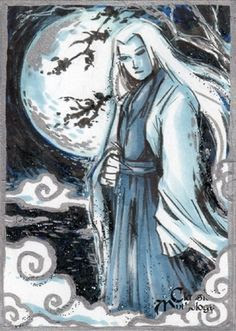Research: Tsukuyomi-no-Mikoto
Following the previous researches, I felt like the next kami that I should research about should be Tsukuyomi, the kami of the moon.
Tsukuyomi-no-Mikoto
Tsukuyomi-no-Mikoto (月読尊, "The Great God Tsukuyomi) or simply Tsukuyomi (月読). The literal translation of his name is "Moon-reading" or "Reading the Moon", a popular practice amongst the noble lords and ladies in the pre-modern Japan in which they will gather all night to gaze at the moon and read poetry. For this reason, sometimes he is also referred as Tsukuhito Otoko ("Moon-reading man") - as there is another kanji symbol (one of the three writing systems of Japan) meaning "moon light" - "tsukuyo" - and "mi"- watching.
Tskuyomi is the kami of the moon in the Shinto religion. Curiously, he is one of the very few male moon gods that there is in the world. In addition to that he is the only god of the moon that is a well-known and important figure in his religion.
As I mentioned in my previous post, Tsukuyomi is one of the children born from the purification ritual of Izanagi. He was born from Izanagi's right eye, Amaterasu from the left one and Susanoo from the nose. After their birth, Izanagi decided that they would rule the Shinto Heaven. For this reason, Tsukuyomi married his sister (as ruling couple) while Susanoo was considered Heaven's guardian. However this marriage did not last and it is unclear if Tsukuyomi his the father of Amaterasu's children and consequently if he his the forefather of the Japanese Imperial Family.
Although Tskuyomi is best known as the god of the moon he is also known for following strictly the rules of etiquette. For the Japanese, this kami is seen as "the traditional conservative male who always looks to maintain and enforce order" (Wright G., n.d.). When his father nominated him as the King of Heaven he took this role very seriously, to the point he killed another kami.
The goddess of food, Uke Mochi, held a feast and invited Tsukuyomi and his wife, Amatrasu. However, Amaterasu could not go so Tsukuyomi went alone. Once he was at the feast, he watched Uke Mochi serving and he became horrified by her methods - she spat rice, fish and deer from her mouth before pulling out food form other orifices. This repulsed Tskuyomi so much that he killed her in that moment.
Even though many believe Tsukuyomi is a evil kami there is also people who worship him. That is to say, that it does not stop him from having shrines such the one in Kyoto - Matsuno'o Taisha.
Although I couldn't find any symbols associated with Tsukuyomi (except the moon), as I had found for Amaterasu, this research helped to understand how the kami is seen for Japanese people. Furthermore, I discovered that though he is seen as an evil kami, he has shrines which I might use as background if I feel that, for people to identify it more easily, it is needed.
Reference:
Wright G. (n.d.) Tsukuyomi [online] Mythopedia, Available from: https://mythopedia.com/japanese-mythology/gods/tsukuyomi/ [Accessed 11.05.2021]
Japanese wiki Corpus (n.d.) Tsukuyomi [online] Available from: https://www.japanese-wiki-corpus.org/Shinto/Tsukuyomi.html [Accessed 11.05.2021]
Symbol Sage (n.d.) Tsukuyomi – The Japanese God of the Moon and Etiquette [online] Available from: https://symbolsage.com/tsukuyomi-japanese-god/#:~:text=The%20kami%20is%20also%20sometimes,popular%20practice%20of%20moon%2Dreading. [Accessed 11.05.2021]Art in Giappone (2017) The Moon and The Japanese Art [online] Availabel from: http://arteingiappone.altervista.org/en/the-moon-and-the-japanese-art/#:~:text=In%20Buddhism%2C%20the%20moon%20has,visible%20face%20of%20the%20moon. [Accessed 12.05.2021]




Comments
Post a Comment